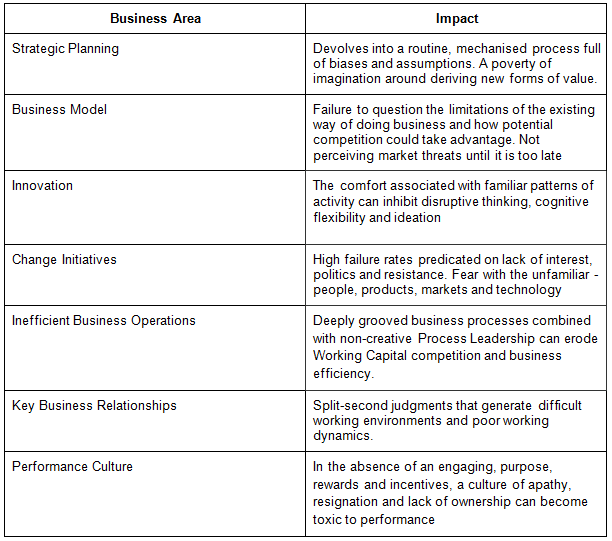
Is it possible that in your market, competitive advantage resides in your executive team's ability to see and create value opportunities that your competition cannot perceive?
Bright Funds, an all-in-one platform for charitable giving, is an example of a company that detected the emerging importance of social consciousness as a driving force among younger consumers. While the company’s initial focus was on individual donations, the executive team sensed a greater opportunity in corporate employee giving programmes. It successfully managed to pivot its technology to this sector and radically increase donation levels.
Conversely, perceptual narrowing and constrained strategic thinking can vaporise shareholder value and kill any organisation. Cutting-edge research in neuroscience is spotlighting the synaptic mechanisms underpinning decision thinking and corporate performance.
The catastrophic demise of companies such as Kodak and the Digital Equipment Corporation and, more recently, Nokia and Garmin illustrates the detrimental impact ingrained neural patterns can have on strategic thinking and competitive advantage.
In today’s fast-moving environment, there is an imperative for the executive team to become aware of its own patterns of thinking, how it processes information, and identifies biases that could impair their judgment, especially in high stakes decisions.
The seeds of demise
Garmin, for example, is a case in point. In 2012, it was the industry leader in GPS navigation devices for cars and ramped sales up to 100 million units.
The Garmin executive team’s pattern of thinking naturally focussed on product development, an approach the vast of majority of organisations would undertake.
What they failed to sense and detect was the potential impending threat of digital platforms. Indeed, apps such as Google Maps and Waze have caused a rapid reduction in sales for Garmin in its car navigation product line.
Future from the past
For the most part, human beings are constrained by the databases of their experiences. In fact, 99 percent of what we see is projected from our memory. Only 1 percent is added by input from our sensory organs. Given the dominance of projected memory, we are able to falsify what is actually out there.
This can have a significant impact on business performance, especially when dealing with difficult problems that require innovative answers predicated on the brain forming new neural connections.
The impact on corporate performance
Besides sub-optimal strategic thinking our inherited cognitive structures can also adversely impact the following areas:

What can the executive do?
Whilst neuroscience is an exciting, expanding field providing valuable insights to how the mind operates, what are the practical takeaways for executives? Here are five practices businesses could immediately institute for improved performance.
- Power of inquiry: Enhance individual and organisational awareness by architecting dialogues within organisations to highlight both hidden limitations and untapped opportunities, e.g. “If constraint X were removed, what impact could it have on the turnover?”
- Future outcome thinking: Working backwards from the desired business outcomes can reveal a multitude of different pathways to deliver on the business intent.
- Strategically adopting the position that existing and new competitors could take to undermine a firm’s strategic direction can be useful in revealing and highlighting flaws and gaps in current logic and approach.
- Altering the context of key change initiatives so that the organisation sees the possibility being bigger than the emotional threat.
- Enhance personal awareness: Identifying those “hot buttons” that set you off and developing practices for self-regulation.
Breaking the addiction to repeating the formulas for past successes is a difficult undertaking for the brain. Garmin’s turnaround has largely depended on its executive team interrupting the company’s reliance on the core automotive segment. Their newly invented Outdoors, Fitness and Wearables segments now account for about 50 percent of their operating profit and have generated renewed optimism for the business.
Vip Vyas is the CEO of Distinctive Performance. He is a thought partner and advisor to boards and executive teams. He can be contacted at [email protected].
Stuart Doughty is an Executive Consultant.
Follow INSEAD Knowledge on Twitter and Facebook.
-
View Comments
-
Leave a Comment





No comments yet.